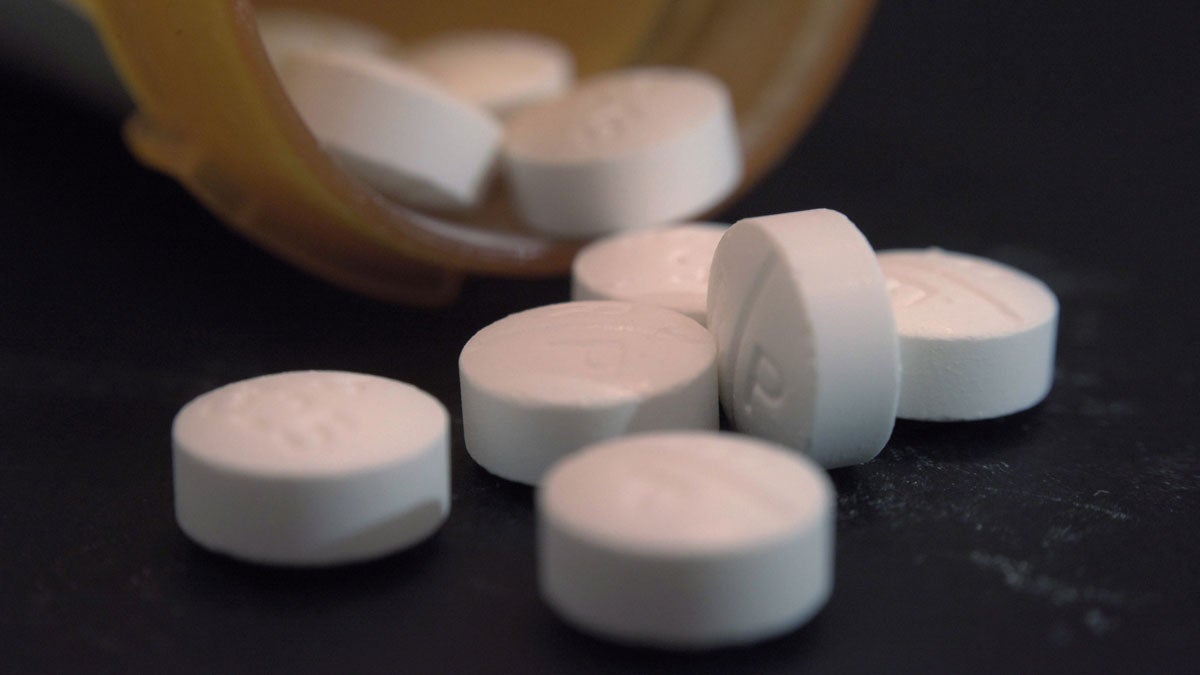Study finds one in three Philadelphia residents used an opioid last year

This Tuesday, Aug. 15, 2017 photo shows an arrangement of pills of the opioid oxycodone-acetaminophen in New York. (Patrick Sison/AP Photo)
One third of adults in Philadelphia have used an opioid in the last year, and the majority of those drugs came directly from a doctor. That’s according to a new city survey, and local health leaders view the findings as a warning and opportunity to better respond to the current drug crisis.
The Philadelphia health department conducted the online survey of 466 residents this May and June, and found that about one in three had used an opioid in the last year. An overwhelming majority, 80 percent, reported getting those opioids directly from a doctor. Dr. Jeanmarie Perrone, an emergency doctor at the University of Pennsylvania, who sits on a citywide opioid taskforce, is not surprised by the results.
“You know, there’s a lot of pills out there and a lot of them came from prescriptions that were to that patient or other family and friends,” said Perrone, who wasn’t involved in the survey or familiar with the details of its design.
Perrone is in a tricky spot. Pain is a common reason people come into the emergency room. She said her department has made changes in recent years, as physicians become more aware of their role. They’ve lowered the number of pills they prescribe for certain conditions, based on more recent research of what’s appropriate. Plus, her department no longer refills outside opioid prescriptions in the ER.
“We used to be the refill guy for everyone, and now we can’t do that anymore,” Perrone said.
For Dr. Tom Farley, head of the city’s health department, the survey points to the need to up the approach to the drug crisis.
“The lion-share of the problem is people getting opioids from their health care provider,” Dr. Farley said. “And this says that there are absolute things we can do to and should be doing to get health care providers to prescribe these drugs less. And if we do that then we’ll have fewer people who get addicted in the first place.”
Fewer people becoming addicted, he says, means fewer people who then turn to heroin and other drugs that are responsible for a recent surge in overdose deaths. In Philadelphia, drug overdose is now the leading cause of death among 25 to 44 year olds and it has jumped to the third leading cause, overall, accounting for more deaths than stroke and respiratory disease.
The health department has sent out prescribing guidelines to 16,000 doctors around the region, and has been working with health plans and hospitals on ways to change the culture. The city also recently launched an ad campaign aimed at educating patients.
Over at Thomas Jefferson University’s emergency department, Dr. Priya Mammen also wasn’t surprised by the new survey results.
“Sadly I don’t think it does shock me,” Dr. Mammen said, who also was not involved in the survey. “It’s definitely high compared to what it should be and what we know is appropriate use of opiates, but I think it’s a reflection of the environment and what’s happening.”
Mammen said one of her main concerns is how long patients take pain pills for. She worries, based on her own research of patients coming into her emergency room, that people aren’t being reassessed or weened off of pain pills properly. She said when it comes to acute pain, for example, opioids should be used for less than three months. But even a three day verses a five day prescription can make a big difference when it comes to preventing opioid dependency. Not everyone who develops a physical dependency becomes addicted, she says, but that’s where addiction starts.
Dr. Perrone echoes this. The greater the number of days someone takes an opioid, she cautions, the greater the risk of long term use. For a small percentage of patients, even one day of a prescription can be an issue. She recommends taking as little as possible for as short a period of time as one can, and then transitioning to aceaminophen or ibuprofen (ie: tylenol or motrin).
Meanwhile, Farley said despite these latest efforts and findings, last week’s back and forth over the President declaring a national emergency points another big challenge: more federal resources are needed on the ground for treatment and prevention. That includes getting the overdose reversal drug, nalaxone, into the hands of more people.
“I think it’s good that the President has declared the crisis a national emergency,” Farley said. “That’s just the first step, though.”
WHYY is your source for fact-based, in-depth journalism and information. As a nonprofit organization, we rely on financial support from readers like you. Please give today.




